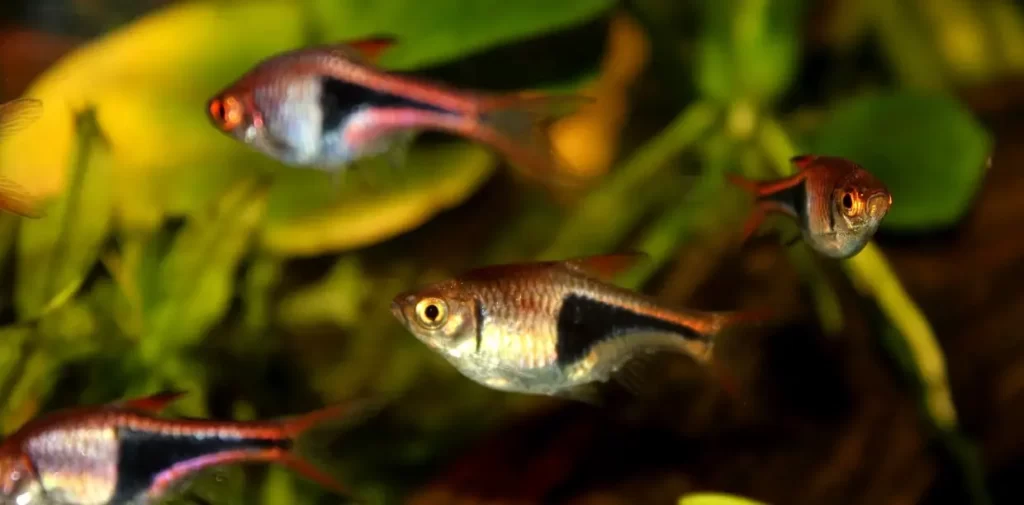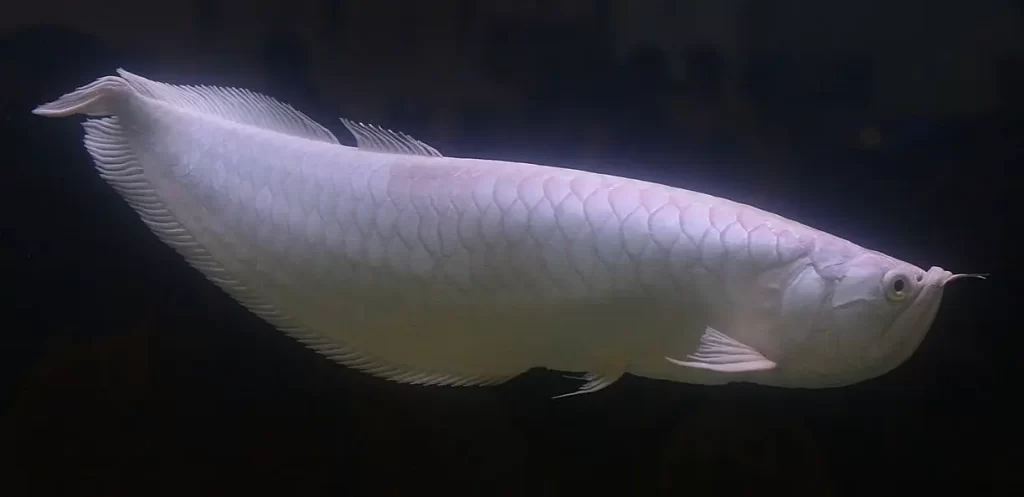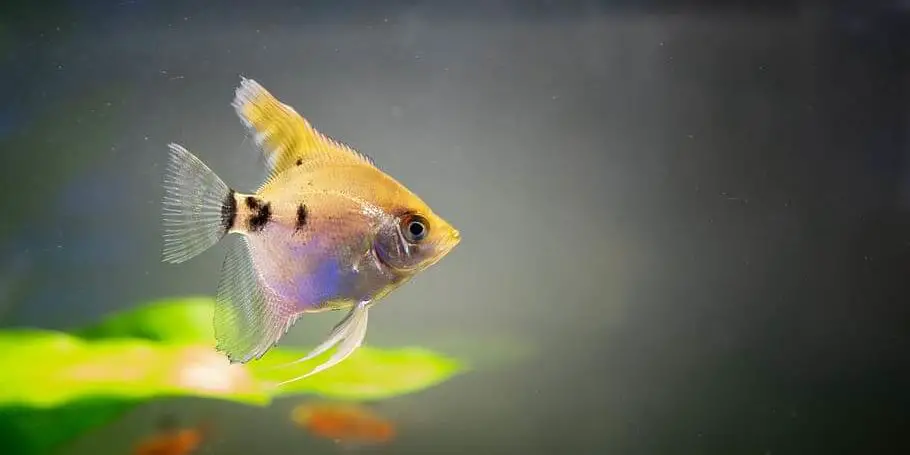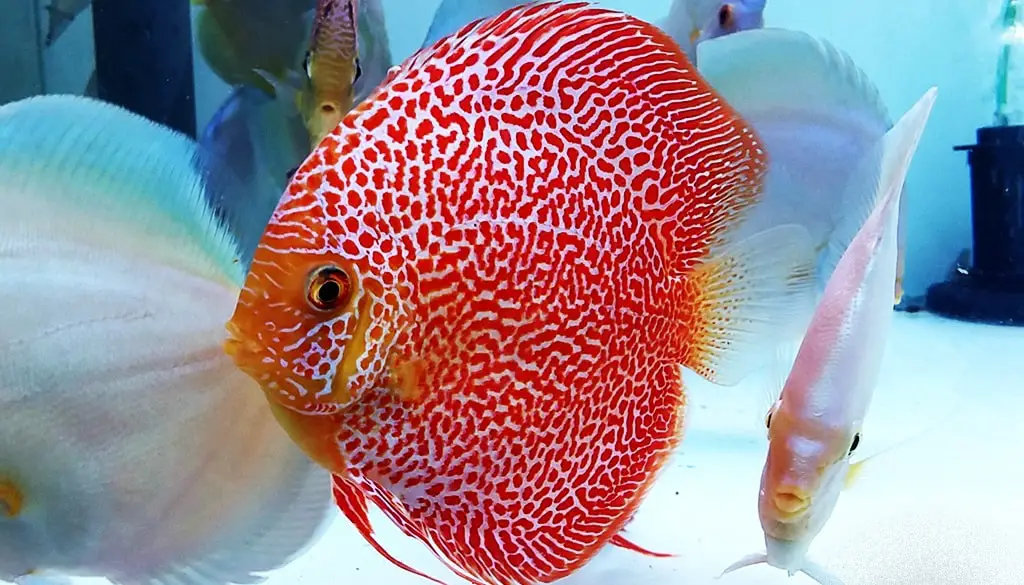Aquarium hobbyists all around the world are familiar with Harlequin Rasbora due to its vibrant metallic color and playful nature. A school of these fish never let you down. You can see constant movements and plays all around your tank if you have placed the harlequins with suitable tankmates. These fish are extremely hardy and suitable for beginner aquarists too. So, if you want to keep rasboras, you need to make it till the end of this article, where I will be discussing everything that the fish requires.
The color orientation on their body makes them more popular among fish keepers. As long as you feed them properly and clean the water in their tank, rasboras will thrive and live to their fullest. In this article, I have tried including every aspect related to the rasbora. Be sure to make it till the end.
Introduction To Harlequin rasbora
Trigonostigma heteromorpha, commonly known as the red rasbora or harlequin rasbora is a blessing to the eye and easy to care for fish. Out of all the species of rasboras, harlequins are the most popular among fish keepers. These fish also get along with others quite well, so if you are a first-time fish keeper, then without any second thought, go for them. These are shoaling fish, which means that they prefer living in a group of the same species. If you are a newbie, start with at least 4-6 rasboras in your tank.
Origin
Harlequin Rasbora fish originates from parts of south-east Asia. These fish can be commonly seen around Malaysia, Singapore, and Thailand. These are specifically found in soft inland water systems. Their natural habitat is poor in minerals but has dissolved humic acids in high concentration. Although rasboras are native to these water systems, due to amazing adapting capabilities, they thrive in any freshwater tank.
Appearance
These fish have a black patch that stretches from their caudal to dorsal fins. This is the reason why they are called Harlequin. The patch is triangular and gets narrower at the tail. Their body color is a combination of silver and orange. The fins color is dark orange, but the shade might differ due to their physical condition. The maximum size that harlequins can reach is about 2 inches, but in some rare circumstances, they might exceed the length.
Male Vs. Female
Due to weak sexual dimorphism, the male and female cannot be differentiated in most cases. Females are identified to be fuller and not as brighter as their male counterparts, but this is always not the best way to differentiate them.
Males are redder in the dorsal and caudal fins. On the other hand, the female is more golden in color. The belly in the female is deeper than that of the male.
Availability
Harlequin Rasbora has been categorized under Least Concern (LC) by the International Union for Conservation of Nature (IUCN). This means that they are not under any focus on being conserved. So, you can find them abundantly in the wild or pet shops.
In a healthy ecosystem, these fish can live up to 6 years. In some cases, harlequins can live longer. The average lifespan of the fish in the wild is higher than in the tank.
Due to their abundant nature, they are cheaply available in your local pet stores with price ranging from 2$ to 3$ for a single fish.
Suitable Tank Mates And Social Behavior
These fish are quite peaceful, so they do quite well with any other non-violent peace-loving fish. Harlequins do well with other rasboras species. Mollies, platies, guppies, and dwarf gourami are some fish that will be good tankmates for rasboras.
Do not keep them with bigger or smaller aggressive fishes like cichlids or bettas. Cichlids will treat them like just another snack and devour them as soon as they are in the tank. Bettas will also give them a tough time because of their aggressive nature. So, always prefer similar peaceful fish.
Difficulty In Keeping Harlequin Rasbora
Due to its hardy and less demanding nature, harlequin rasbora is preferred all around the world. You may not face any difficulty while keeping them. But, maintaining slightly acidic water all the time might be a little challenging.
This might literally be the only challenge you may face while keeping harlequin rasboras.
Caring For Harlequin Rasbora
Caring a fish is never that easy either hardy or not. These fish need your attention most of the time and are sensitive animals. Although Harlequins are hardy, you must take proper care of every parameter. You must feed them in time and remove the food that remains in time.
In this section, I am going to write about caring for your harlequin rasbora. I am going to write about tank size, tank conditions, and diet of the fish.
Maintaining Water Parameters
To get the best out of these fish and make them sparkle 24*7, you must maintain your tank properly. Maintaining water parameters not only keeps your fish thrive but also helps to prevent any diseases, some of which may be fatal. Although rasboras have an amazing adapting ability, some aspects like temperature, pH, and hardness should be strictly monitored.
If you fail to maintain any one of these aspects, then your fish may have to experience severe consequences.
Temperature
Rasboras prefer a temperature of about 70-82 F. To maintain the temperature of such a high range, a heater must be installed and used throughout the day. You must prepare for a power backup in case of electricity cut off.
pH And hardness
A pH of range of 5.5 to 7 is perfect for them to thrive. Acidic water is preferred by these fish over alkaline water. So, to maintain the acidity, you can use peat moss in the filter and increase the CO2 level by adding more plants.
Hardness must be minimized as much as you can and kept at around 1-10 dGH or dKH. In order to have minimal hardness, chemicals should be added to tap water to remove magnesium and calcium.
Using driftwood is a common way to reduce both alkalinity and hardness from the water.
Filtration
A powerful filter with high suction capacity might give them trouble in swimming. A filter providing both chemical and mechanical filtration must be used. During the breeding process, they require clean water, so filters must be activated throughout the day.
After the fries are born, the filter must be turned off because they are extremely small and can be sucked in by the filter.
Water Maintenance
A 10% water change must be performed weekly at any cost. The main reason to do this is to remove any uneaten food pieces. This helps to reduce the nitrate level in the tank and prevents unwanted growth of algae.
Also, a water test kit must be used every fifteen days in order to check the concentration of ammonia, nitrate, phosphate, and other chemicals. After measuring these chemicals, actions must be taken to reduce them if necessary.
The fish should not be added in a tank without performing a nitrogen cycle for about 2 to 3 weeks. Also, the uneaten food pieces must be removed within 5 minutes or excessive nitrate, and ammonia can be seen, which hampers the nitrogen cycle.
Tank Size And Condition.
For a shoal of at least 4-6 fish, a tank size of 10 gallons is suitable. For every one fish you add later, two gallons must be increased at least.
These fish also do not prefer water with any current. A moderate stream can be suitable because these fish originate in Asian rivers with moderate current.
These fish will only reproduce in a planted aquarium with warm, soft acidic water. These fishes are middle dwellers, so it doesn’t matter what you use as a substrate.
Harlequins are mostly preferred to be kept in a school of around 4-6 fishes.
Plants of Cryptocoryne species must be planted in a tank of rasboras to resemble the tank to their natural habitat.
Lighting
Low-intensity lights must be used. To reduce the intensity of your normal lights, you can place floating plants like duckweed at the surface. High intensity of light might give stress to your fish so, using subdued light is the best option.
Decorations And Substrate
Plants, rocks, and driftwoods must be used as decorations. This will help you to resemble the tank to their natural habitat. Rocks will also provide hiding space and save them from any threats. Plants and rocks must be kept in such a way that the swimming space is not obstructed. To do this, you must not center the plants; rather, they should be kept at the back or sides of the tank.
As harlequin rasboras are not that much of bottom dwellers so, you can use any type of substrate. But if you want some substrate, then sand must be preferred over gravel.
Harlequin Rasbora Diet
Harlequins are omnivores, meaning their diet should consist of food ranging from veggies to meat. Since they are small, you should make sure that the food you give them is properly crushed and is in powder form.
Also, vary their diet from time to time not only for a nutritional purpose but also for keeping them interested. These fish accept flake, frozen, live, and dried food. A varied diet also ensures that your fish has a healthy digestive system and is not susceptible to diseases. In the wild, their diet is limited to insect larvae and eggs and algae. But in your tank, you have unlimited options. In the tank also algae can be given as food. The harlequin rasbora loves pretty much anything you throw at it. From your standard freeze-dried blood worm to small live foods like shrimps, these guys will eat almost anything. Just make sure that you crush the food small enough to fit in their tiny mouth.
Harlequin Rasbora Disease
Being hardy fish, they don’t get sick that often. But without proper care, several kinds of disease may commonly affect them like any other fish.
The disease that commonly affects harlequin rasboras is dropsy, ich, and fin rot.
The diseases are mainly seen due to poor water conditions, lack of nutrition, stress, and harmful bacteria that are living in your aquarium.
So, cleaning your aquarium now and then, providing a balanced diet with proper nutrition amount, keeping the fish away from bullying, and cleaning the filter media occasionally can help you prevent your fish from getting these diseases. Overstocking can be a significant cause of bullying and stress, so minimize it a much as you can.
Breeding
Unfortunately, breeding harlequins in an aquarium is very difficult. But if done under proper conditions, then it is possible. You must make the environment very hospitable for the fish to reproduce. They need proper nutritious food and a well-maintained temperature. The water parameters must be almost the same as their natural habitat.
The best way to breed them is to separate males and females in a separate breeding tank. These fish have an interesting way of reproducing. First of all, the female takes the male to the top of the tank. There the pair cuddles for a while and turns their abdomens up. Later, the female sticks the eggs under the leaves that are around her. She will probably stick it at the bottom side of the leaf.
Always keep two females for a male, but since they are not that aggressive, you can keep the ratio equal also. After the female laid the eggs, separate the parents to another tank. Because there is a chance that these fish will eat their eggs. Now you have to take proper care if the eggs by maintaining a warm temperature. The fries shall not be immediately mixed with the adults after birth. These fish must be given some time to grow up. Fries can also eat almost anything from feces to powdered foods. Finally, when they are ready to be mixed with the adults, make sure that the water parameter of the new tank is the same.
Is Harlequin Rasbora Suitable For Your Tank?
If you are completely new at fishkeeping and have almost no idea about complex stuff and fishes, then you should start with fishes like these. Keeping hardy fish like harlequins, guppies, dwarf gouramis, etc. can boost your confidence, and it is good for the long run.
These fish are very peaceful and go quite well with any other fish. You will not notice a single case of intra-species bullying. Rasboras are also prone to less disease; however, bloating and minor bacterial infections can be obvious if you have not maintained the water properly according to their requirements. Being hardy fish, they don’t require your constant attention towards maintaining chemical balance.
Conclusion
To sum it all up, Harlequin Rasboras are very hardy fish and require very little care and attention. But this doesn’t mean that you place it in the tank and don’t even look at it. All the things I have mentioned above is enough for a beginner to start their fish keeping journey with Harlequin Rasboras.
I think I have covered every detail related to these fish, and now you are ready to keep a school. If you are a beginner, I suggest you go through this article very carefully and follow each instruction precisely.






